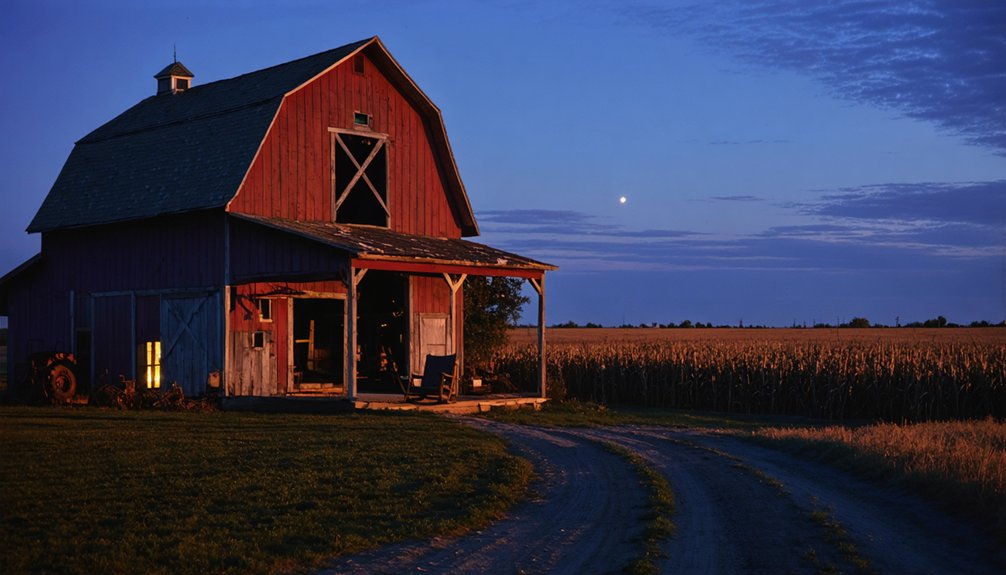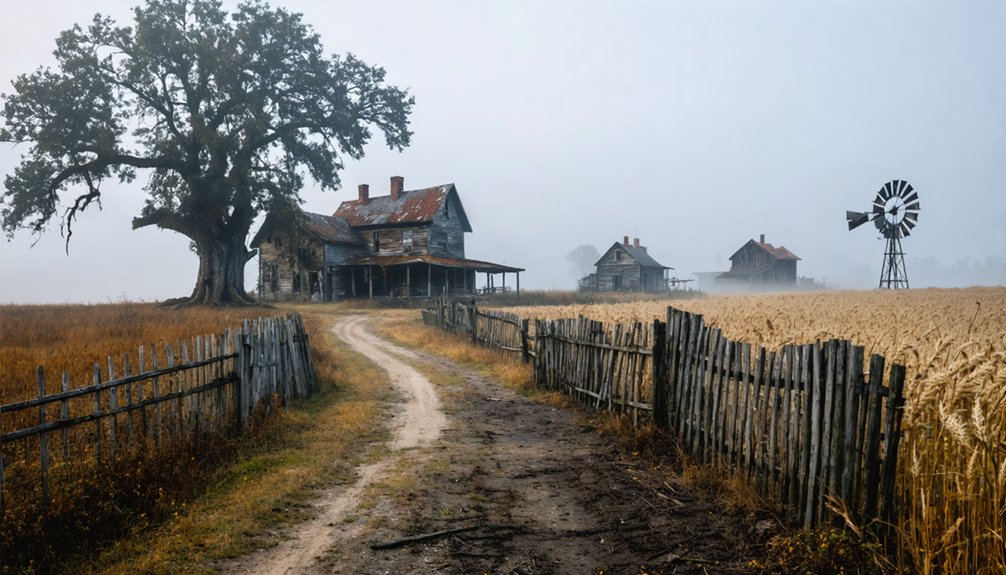When exploring abandoned homestead legends, start by researching historical records at county offices and BLM archives. Utilize GPS mapping technology for accurate documentation of remote locations. Learn to identify key structural remains and period-specific artifacts at sites. Always follow safety protocols including bringing a companion and proper protective equipment. Connect with local historical societies and Indigenous communities to uncover hidden narratives. These foundational steps will transform your exploration from simple observation to meaningful historical discovery.
Key Takeaways
- Research land records and historical documents to uncover the true stories behind local homestead legends.
- Document structural remains and artifact locations using GPS mapping for accurate site documentation.
- Connect with local historical societies and Indigenous communities who may hold undocumented knowledge about sites.
- Practice safety protocols including bringing companions and proper gear when exploring remote abandoned locations.
- Look for physical evidence like foundations, domestic artifacts, and vegetation patterns that verify legendary accounts.
Research Historical Records Before Your Journey
Before commencing your exploration of abandoned homesteads, thorough investigation of historical records is essential to understanding the property’s significance and accurately locating its boundaries.
Begin with county recorder offices to obtain land ownership histories and legal descriptions following the rectangular survey system (section, township, range).
Access the Bureau of Land Management‘s General Land Office Records online to discover patent dates, acreage information, and original homesteader names. Cross-reference these findings with primary sources like deeds, tax records, and census data.
Don’t overlook genealogical research opportunities within homestead applications, which often contain family Bible pages, marriage certificates, and citizenship papers. These documents reveal kinship ties and previous residences, providing context for your exploration. Even if the homestead was never completed, you can still obtain valuable application papers from the National Archives.
Military service records may also appear in these files, offering additional historical insights.
Ensure you document the physical characteristics of any structures you encounter, as these details are crucial for establishing the property’s historic integrity and significance.
Master GPS Mapping for Remote Site Documentation
Accurately documenting abandoned homesteads requires mastering GPS mapping techniques tailored for remote locations where conventional references may be unavailable. Select survey-grade or RTK GPS units for centimeter-level accuracy when mapping structural remains. Configure your device to match the coordinate system of your reference maps, and conduct multiple readings at each point to minimize inherent GPS errors. Comparing historical imagery through Google Earth can provide valuable context about past site conditions and structural changes over time. Lidar technology can reveal subtle terrain anomalies that indicate the presence of former structures not visible to the naked eye.
- Calibrate your GPS using stable reference points and document all device settings for quality assurance.
- Collect data using kinematic surveying with stationary base units and mobile rovers for precise spatial context.
- Cross-reference coordinates with satellite imagery to validate subtle ruins and landscape alterations.
- Geo-reference historical maps with 6-12 control points before integrating your GPS data into GIS platforms.
Identify Key Structural Remains and Artifacts
Successful exploration of abandoned homesteads hinges on your ability to recognize and interpret key structural elements and artifacts that reveal the site’s history.
Your success in homestead exploration depends entirely on reading the silent language of ruins and relics.
When conducting structural analysis, look for rectangular depressions or raised stone foundations measuring approximately 12 by 18 feet for 1700s-era homesteads. Note uneven floors, horizontal cracks near doorways, and shifted masonry that indicate foundation movement. Be especially vigilant for musty odors that can indicate hidden water damage and wood rot in remaining structures.
For artifact identification, focus on domestic remnants like mason jar bottoms, metal objects, and stove parts. You’ll often discover these items in refuse zones located downslope behind the main structure. Keep an eye out for farm equipment parts which frequently appear scattered around old homesteads and can provide insights into the property’s agricultural history.
Pay attention to vegetation patterns and soil disturbances that may signal buried structures. Large, mature trees—especially oaks—frequently marked homestead boundaries or provided shade for living areas.
Document your findings using GPS to create thorough site maps that preserve the homestead’s historical footprint.
Follow Essential Safety Protocols in Isolated Terrain
Exploring abandoned homesteads carries significant risks that demand meticulous preparation and awareness. Effective risk management begins with thorough research of the site’s history, structural integrity, and potential hazards before your arrival.
Always carry appropriate safety gear including N95 respirators to protect against black mold and asbestos, heavy-duty gloves for handling debris, and sturdy hiking boots to navigate uneven terrain.
- Never explore alone—bring at least one companion for emergency assistance
- Survey the building exterior first to identify structural weaknesses or collapse risks
- Download offline maps and carry a compass to maintain orientation in remote locations
- Pack a first aid kit, whistle, and fully charged communication devices for emergencies
Remember to respect both historical elements and private property rights while prioritizing your personal safety above exploration objectives. Consider using mentholated ointments to combat unpleasant odors that are often present in abandoned structures. A group of 3-6 people is ideal for homestead exploration as it provides adequate supervision while maintaining manageable communication.
Connect With Local Communities for Hidden Knowledge
The richest discoveries about abandoned homesteads often lie not in official records or published guides, but in the collective memory of those who’ve lived alongside these forgotten places for generations.
Engage with local historical societies, which maintain valuable archives containing maps, photographs, and personal accounts from former homesteaders. Their members can direct you to resources unavailable online and often host events centered on local legends.
Indigenous communities hold particularly valuable knowledge, including traditional ecological insights and oral histories that explain the cultural significance behind abandoned sites.
Community storytelling flourishes at heritage festivals and town gatherings, where longtime residents share firsthand knowledge of hidden trails and access points.
Online forums connect you with fellow enthusiasts who provide real-time updates on site conditions. Developing your pattern recognition skills by observing signs of neglect like overgrown vegetation and deteriorating roofs will help identify potential sites more efficiently. With nearly 4,000 ghost towns scattered across America, these connections become essential for comprehensive exploration. By respecting cultural protocols and building trust, you’ll reveal layers of hidden knowledge that official documentation never captured.
Frequently Asked Questions
How Can I Legally Explore Homesteads on Private Property?
You must obtain explicit property permissions from landowners before exploration. Contact them formally, secure written consent, and follow landowner etiquette by respecting their terms regarding access, photography, and artifact documentation.
Can I Keep Artifacts Found at Abandoned Homestead Sites?
You can’t legally keep artifacts from abandoned homesteads on federal lands. On private property, you’ll need explicit owner permission while considering artifact preservation and ethical considerations of historical significance.
What’s the Best Season for Homestead Exploration?
Can you imagine traversing a homestead as it emerges from winter’s grip? Fall offers the best weather for exploration, with seasonal changes revealing foundations while providing moderate temperatures for your extended backcountry investigations.
How Do I Distinguish Natural Features From Human-Made Remains?
You’ll identify human-made remains by looking for geometric patterns, alignment, and artifacts, while natural signs appear irregular and random. Understanding the historical context helps interpret ambiguous features systematically.
What Camera Equipment Best Documents Deteriorating Homestead Structures?
Capture time’s gentle erosion with a full-frame mirrorless camera, employing wide angle lenses for contextual interior shots. You’ll need tripods for low-light stability, while drone photography documents structural relationships from previously inaccessible perspectives.
References
- https://www.americanhauntingsink.com/myrtles
- https://files.eric.ed.gov/fulltext/ED479233.pdf
- https://tnecd.com/news/ghostly-whispers-and-country-legends-the-story-of-loretta-lynns-haunted-ranch/
- https://www.youtube.com/watch?v=oN5_1xbGFhc
- https://www.dncr.nc.gov/blog/2017/10/25/8-folktales-legends-and-mysteries-north-carolina-history
- https://www.youtube.com/watch?v=dre_HX6NtrE
- https://www.legendsofamerica.com/gt-hiddentales/
- https://www.theprairiehomestead.com/2013/06/homesteading-critics.html
- https://www.youtube.com/watch?v=qf8jm-GhwNY
- https://www.homestead.org/lifestyle/knowledge-in-numbers-starting-a-homestead-community/



